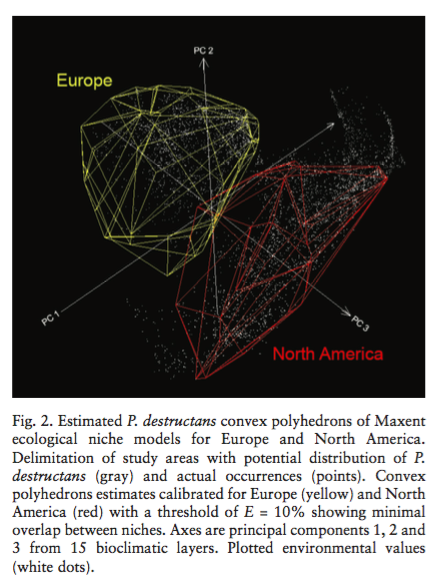Escobar et al. (2014) model the range of Pseudogymnoascus destructans, the pathogenic fungus that causes white nose syndrome (WNS) in bats, in North America and Europe. They collected 218 observations of WNS for use in Maxent species distribution models. Variables in their model included the usual suspects (temperature, etc) along with some that are more important for modeling bat & fungus distribution (mean temperatures of coldest winters, annual precipitation, etc). Maxent models were then carried out on buffer areas of 500 km around European and North American occurrences. After calibration with Maxent of the training data in the two continents, projections of distributions to South America were generated. Three different approaches for projection were used: one without extrapolation, one with extrapolation, and NICHE-A models. NICHE-A models describe the fundamental niche in environmental space, thus identifying potential geographic places that may fall inside the minimum environmental ellipsoid containing all training points. In order to understand habitat differences in North America and Europe, the authors conducted tests for background similarity. They found that the two areas did not diverge significantly across the two continents, suggesting no real niche differentiation has demonstrably taken place between the two continents. However, depending on the projection approach and training data origin (from N America, Europe, or N America & Europe), Maxent transfer models differed markedly. Their use of NICHE-A, which reminds me of RangeBag, produced similar results to Maxent. I’m not sure I fully buy their results of projection to South America, given the differing community composition of bat species in South America and lack of clear evidence that WNS can infect these differing bat species. Even if these results give rise to error of commission in modeling WNS, I think the study is important because it can point ecologists and conservationists to regions at risk for transmission.
Escobar, L.E. et al., 2014. Potential for spread of the white-nose fungus (Pseudogymnoascus destructans) in the Americas: use of Maxent and NicheA to assure strict model transference. Geospatial Health, 9(1), pp.221–229. link to paper
